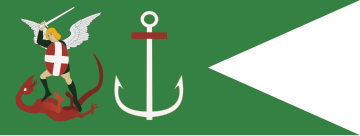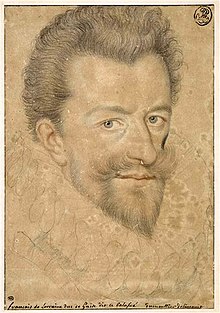
Henry IV, also known by the epithets Good King Henry or Henry the Great, was King of Navarre from 1572 and King of France from 1589 to 1610. He was the first monarch of France from the House of Bourbon, a cadet branch of the Capetian dynasty. He pragmatically balanced the interests of the Catholic and Protestant parties in France, as well as among the European states. He was assassinated in Paris in 1610 by a Catholic zealot, and was succeeded by his son Louis XIII.

Francis II was King of France from 1559 to 1560. He was also King of Scotland as the husband of Mary, Queen of Scots, from 1558 until his death in 1560.

Charles IX was King of France from 1560 until his death in 1574. He ascended the French throne upon the death of his brother Francis II in 1560, and as such was the penultimate monarch of the House of Valois.
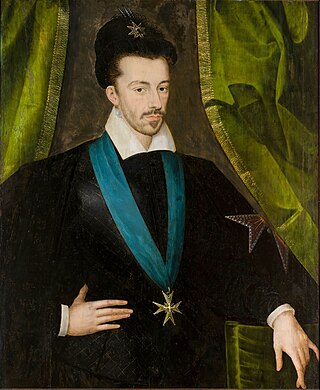
Henry III was King of France from 1574 until his assassination in 1589, as well as King of Poland and Grand Duke of Lithuania from 1573 to 1575.

The French Wars of Religion were a series of civil wars between French Catholics and Protestants from 1562 to 1598. Between two and four million people died from violence, famine or disease directly caused by the conflict, and it severely damaged the power of the French monarchy. One of its most notorious episodes was the St. Bartholomew's Day massacre in 1572. The fighting ended with a compromise in 1598, when Henry of Navarre, who had converted to Catholicism in 1593, was proclaimed King Henry IV of France and issued the Edict of Nantes, which granted substantial rights and freedoms to the Huguenots. However, Catholics continued to disapprove of Protestants and of Henry, and his assassination in 1610 triggered a fresh round of Huguenot rebellions in the 1620s.

The House of Guise was a prominent French noble family that was involved heavily in the French Wars of Religion. The House of Guise was the founding house of the Principality of Joinville.

Jacques Clément was a French conspirator and the regicide of King Henry III.

Gaspard de Coligny, seigneur de Châtillon, was a French nobleman, Admiral of France, and Huguenot leader during the French Wars of Religion. He served under kings Francis I and Henry II during the Italian Wars, attaining great prominence both due to his military skill and his relationship with his uncle, the king's favourite Anne de Montmorency. During the reign of Francis II he converted to Protestantism, becoming a leading noble advocate for the Reformation during the early reign of Charles IX.

Antoine, sometimes called Antoine of Bourbon, was King of Navarre from 1555 until his death in 1562 as the husband and co-ruler of Queen Jeanne III. He was the first monarch of the House of Bourbon, of which he became head in 1537. Despite being first prince of the blood in France, Navarre lacked political influence and was dominated by King Henry II of France's favourites, the Montmorency and Guise families. When Henry II died in 1559, Navarre found himself sidelined in the Guise-dominated government, and then compromised by his brother's treason. When Henry's son, King Francis II of France, soon died in turn, Navarre returned to the centre of politics, becoming Lieutenant-General of France and leading the army of the crown in the first of the French Wars of Religion. He died of wounds sustained during the Siege of Rouen. He was the father of King Henry IV, France's first Bourbon king.
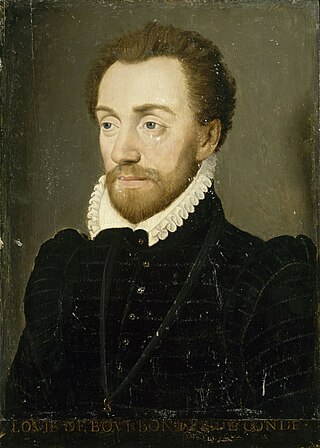
Louis de Bourbon, 1st Prince of Condé was a prominent Huguenot leader and general, the founder of the Condé branch of the House of Bourbon. Coming from a position of relative political unimportance during the reign of Henri II, Condé's support for the Huguenots, along with his leading role in the conspiracy of Amboise and its aftermath, pushed him to the centre of French politics. Arrested during the reign of Francis II then released upon the latter's premature death, he would lead the Huguenot forces in the first three civil wars of the French Wars of Religion before being executed after his defeat at the Battle of Jarnac in 1569.
The War of the Three Henrys, also known as the Eighth War of Religion, took place during 1585–1589, and was the eighth conflict in the series of civil wars in France known as the French Wars of Religion. It was a three-way war fought between:

The Edict of Saint-Germain, also known as the Edict of January, was a landmark decree of tolerance promulgated by the regent of France, Catherine de' Medici, in January 1562. The edict provided limited tolerance to the Protestant Huguenots in the Catholic realm, though with counterweighing restrictions on their behaviour. The act represented the culmination of several years of slowly liberalising edicts which had begun with the 1560 Edict of Amboise. After two months the Paris Parlement would be compelled to register it by the rapidly deteriorating situation in the capital. The practical impact of the edict would be highly limited by the subsequent outbreak of the first French Wars of Religion but it would form the foundation for subsequent toleration edicts as the Edict of Nantes of 1598.

The Peace of Saint-Germain-en-Laye was signed on 8 August 1570 by Charles IX of France, Gaspard II de Coligny and Jeanne d'Albret, and ended the 1568 to 1570 Third Civil War, part of the French Wars of Religion.

The Battle of Coutras, fought on 20 October 1587, was a major engagement in the French Religious Wars between a Huguenot (Protestant) army under Henry of Navarre and a royalist army led by Anne, Duke of Joyeuse. Henry of Navarre was victorious, and Joyeuse was killed while attempting to surrender.

The siege of Rouen was a key military engagement of the first French War of Religion. After having been seized by those opposing the crown on 16 April, the siege, beginning on 28 May and culminating on 26 October brought the important city of Rouen back into the crowns control. The fall of Rouen would set the stage for the main battle of the war at Dreux several months later.

The Edict of Amboise, also known as the Edict of Pacification, was signed at the Château of Amboise on 19 March 1563 by Catherine de' Medici, acting as regent for her son Charles IX of France. The Edict ended the first stage of the French Wars of Religion, inaugurating a period of official peace in France by guaranteeing the Huguenots religious privileges and freedoms. However, it was gradually undermined by continuing religious violence at a regional level and hostilities renewed in 1567.
Articles of the Treaty of Nemours were agreed upon in writing and signed in Nemours on 7 July 1585 between the Queen Mother, Catherine de' Medici, acting for the King, and representatives of the House of Guise, including the Duke of Lorraine. Catherine hastened to Saint-Maur-des-Fossés, where on 13 July the treaty was signed between King Henry III of France and the leaders of the Catholic League, including Henri, duc de Guise. The king was pressured by members of the Catholic League to sign the accord which was recognized by contemporaries as a renewal of the old French Wars of Religion.
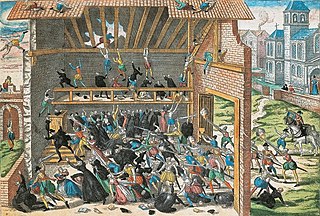
The Massacre of Vassy was the murder of Huguenot worshippers and citizens in an armed action by troops of the Duke of Guise, in Wassy, France on 1 March 1562. The massacre is identified as the first major event in the French Wars of Religion. The series of battles that followed concluded in the signing of the Peace of Amboise on 19 March 1563.

Charles de Bourbon, known as the Cardinal de Bourbon, was a French noble and prelate. He was the Archbishop of Rouen from 1550 and the Catholic Ligue candidate for King of France from 1589.
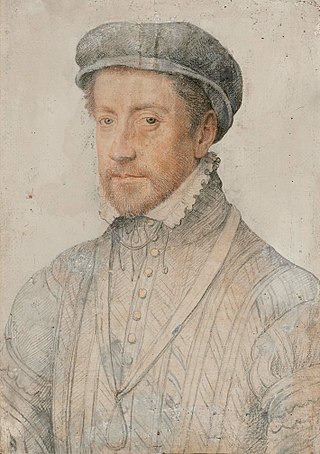
Louis de Bourbon, Duc de Montpensier was the second Duke of Montpensier, a French Prince of the Blood, military commander and governor. He began his military career during the Italian Wars, and in 1557 was captured after the disastrous battle of Saint-Quentin. When his liberty was restored, he found himself courted by the new regime as it sought to steady itself and isolate its opponents in the wake of the Conspiracy of Amboise. At this time Montpensier supported liberalising religious reform, as typified by the Edict of Amboise he was present for the creation of.
